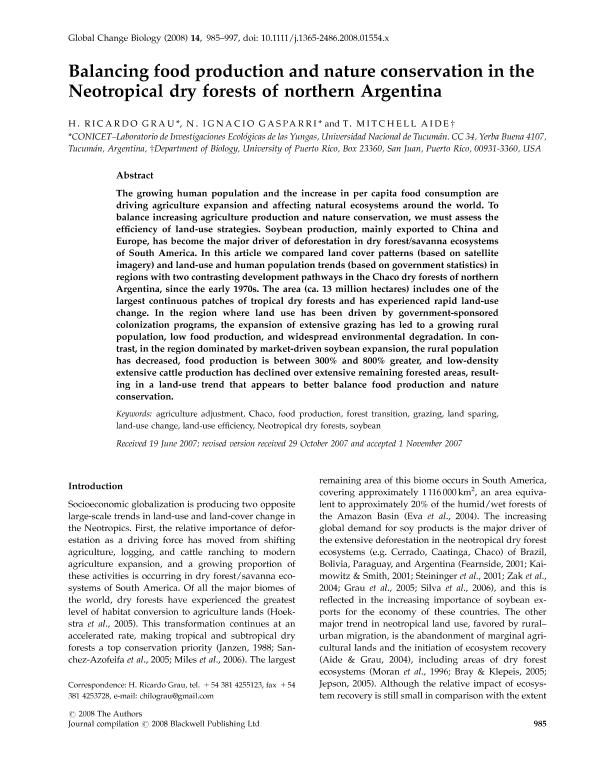Mostrar el registro sencillo del ítem
dc.contributor.author
Grau, Hector Ricardo

dc.contributor.author
Gasparri, Nestor Ignacio

dc.contributor.author
Aide, Michelle T.
dc.date.available
2019-07-15T15:56:30Z
dc.date.issued
2008-12
dc.identifier.citation
Grau, Hector Ricardo; Gasparri, Nestor Ignacio; Aide, Michelle T.; Balancing food production and nature conservation in the Neotropical dry forests of northern Argentina; Wiley Blackwell Publishing, Inc; Global Change Biology; 14; 5; 12-2008; 985-997
dc.identifier.issn
1354-1013
dc.identifier.uri
http://hdl.handle.net/11336/79536
dc.description.abstract
The growing human population and the increase in per capita food consumption are driving agriculture expansion and affecting natural ecosystems around the world. To balance increasing agriculture production and nature conservation, we must assess the efficiency of land‐use strategies. Soybean production, mainly exported to China and Europe, has become the major driver of deforestation in dry forest/savanna ecosystems of South America. In this article we compared land cover patterns (based on satellite imagery) and land‐use and human population trends (based on government statistics) in regions with two contrasting development pathways in the Chaco dry forests of northern Argentina, since the early 1970s. The area (ca. 13 million hectares) includes one of the largest continuous patches of tropical dry forests and has experienced rapid land‐use change. In the region where land use has been driven by government‐sponsored colonization programs, the expansion of extensive grazing has led to a growing rural population, low food production, and widespread environmental degradation. In contrast, in the region dominated by market‐driven soybean expansion, the rural population has decreased, food production is between 300% and 800% greater, and low‐density extensive cattle production has declined over extensive remaining forested areas, resulting in a land‐use trend that appears to better balance food production and nature conservation.
dc.format
application/pdf
dc.language.iso
eng
dc.publisher
Wiley Blackwell Publishing, Inc

dc.rights
info:eu-repo/semantics/openAccess
dc.rights.uri
https://creativecommons.org/licenses/by-nc-sa/2.5/ar/
dc.subject
Agriculture Adjustment
dc.subject
Deforestation
dc.subject
Forest Transition
dc.subject
Soya
dc.subject.classification
Ecología

dc.subject.classification
Ciencias Biológicas

dc.subject.classification
CIENCIAS NATURALES Y EXACTAS

dc.title
Balancing food production and nature conservation in the Neotropical dry forests of northern Argentina
dc.type
info:eu-repo/semantics/article
dc.type
info:ar-repo/semantics/artículo
dc.type
info:eu-repo/semantics/publishedVersion
dc.date.updated
2019-07-10T14:41:02Z
dc.journal.volume
14
dc.journal.number
5
dc.journal.pagination
985-997
dc.journal.pais
Reino Unido

dc.journal.ciudad
Londres
dc.description.fil
Fil: Grau, Hector Ricardo. Universidad Nacional de Tucumán. Facultad de Ciencias Naturales e Instituto Miguel Lillo; Argentina. Consejo Nacional de Investigaciones Científicas y Técnicas. Centro Científico Tecnológico Conicet - Tucumán; Argentina
dc.description.fil
Fil: Gasparri, Nestor Ignacio. Consejo Nacional de Investigaciones Científicas y Técnicas. Centro Científico Tecnológico Conicet - Tucumán; Argentina
dc.description.fil
Fil: Aide, Michelle T.. University of Puerto Rico; Puerto Rico
dc.journal.title
Global Change Biology

dc.relation.alternativeid
info:eu-repo/semantics/altIdentifier/doi/https://dx.doi.org/10.1111/j.1365-2486.2008.01554.x
dc.relation.alternativeid
info:eu-repo/semantics/altIdentifier/url/https://onlinelibrary.wiley.com/doi/full/10.1111/j.1365-2486.2008.01554.x
Archivos asociados
